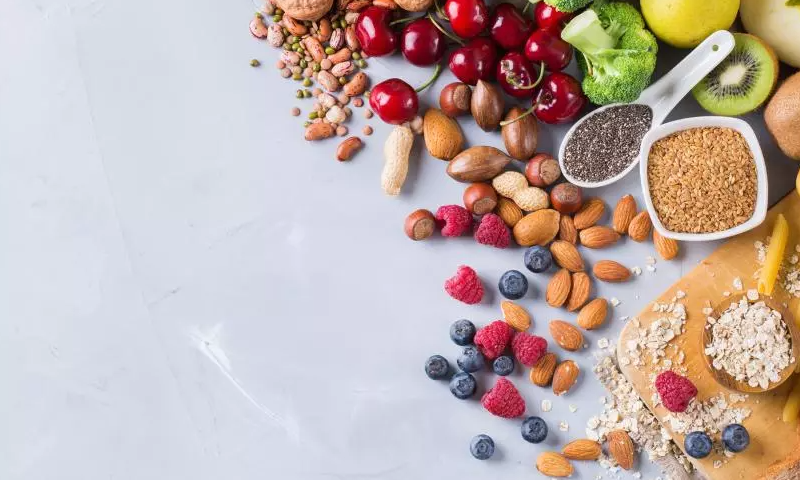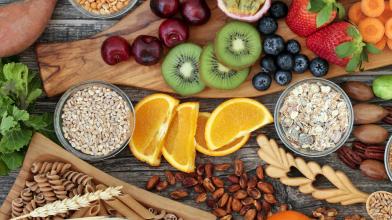If you have diabetes, eating high-fiber foods every day can help you manage blood glucose (blood sugar), improve heart health, and keep your digestive system healthy. Here are some things you should know about fiber along with ideas on how to include more of it in your daily eating plan.
What is fiber and does it help?
Fiber is a carbohydrate (carb) the body can’t break down when digesting food. Foods that are higher in fiber can help slow the breakdown of other carbs you eat, which may also help slow the rise in blood glucose. Some types of fiber can also help lower cholesterol levels. High-fiber foods include grains, vegetables, fruits, beans, and legumes.
There are two types of fiber: soluble and insoluble.
Soluble fiber
This type of fiber dissolves in water and turns into a gel. It may help lower your cholesterol and affects how carbs raise blood glucose levels. Soluble fiber is found in oats, peas, beans, apples, citrus fruits, and carrots. Try to include 6-8 grams of soluble fiber in your eating plan each day. Some sources include:
- A medium apple, pear or ½ cup berries are about 5 grams soluble fiber
- ½ cup sweet potato or brussels sprouts contain 2 grams soluble fiber
- an orange, ½ cup mango or 4 apricots contain about 2 grams soluble fiber
Insoluble fiber
This type of fiber helps you digest food by helping to keep the food you eat moving through your digestive system. It also adds to the bulk of your stool. Insoluble fiber may help if you have constipation or irregular stools. Good sources of insoluble fiber include:
- Wholegrains
- wheat bran
- nuts
- beans
- vegetables (such as cauliflower, green beans, and potatoes) and fruits. Keep the skin on vegetables and fruits when you can to add even more soluble fiber
How much fiber should you eat?
Did you know that, according to the Centers for Disease Control and Prevention (CDC), most American adults only get half the fiber they need per day? Men should aim for 38 grams per day (30 grams after age 50) and women should aim for 25 grams (21 grams after age 50).
Here is a sample menu that contains at least 30 grams of fiber:
- Breakfast: 1 sliced apple (with skin) and 2 T. peanut butter (6 grams fiber)
- Lunch: ½ cup navy bean chili (10 grams fiber); 1 cup steamed broccoli, cauliflower and carrots (3 grams fiber)
- Dinner: Fish taco with ½ cup black beans in a whole wheat tortilla (11 grams fiber); ¼ cup sliced avocado (2.5 grams fiber); leafy green salad with sliced tomato (1 gram fiber)
For those needing to boost their fiber to at least 38 grams per day, you can use the same menu and add 1 ounce of pumpkin seeds to reach the recommended fiber.
Keep in mind that foods that are higher in fiber are also sources of carbs. When you’re choosing a carb for your meal, choose a high fiber option when you can (like whole wheat bread).
What foods are high in fiber?
Here is a list of some of the highest sources to include in your meals:
- One cup of cooked lima beans: 13 grams
- One cup of cooked artichokes: 10 grams
- Half a cup of cooked navy beans: 10 grams
- One cup of raspberries or blackberries: 8 grams
- Half a cup of cooked split peas: 8 grams
- Half a cup of cooked lentils: 8 grams
- Half a cup of cooked black beans: 8 grams
- One pear with skin: 6 grams
- One cup of jicama: 6 grams
- One cup of cooked broccoli: 5 grams
- One apple with skin: 5 grams
- One medium orange: 4 grams
You may see a food or recipe labeled as an “excellent” or “good” source of fiber—but what does that mean? An excellent source contains 10% of your daily value of fiber (5 grams or more) and a good source contains 5% daily value (2.5–4.9 grams). When looking at the Nutrition Facts label on packaged foods, find the higher fiber choices by looking for at least 2.5 grams, or even better, 5 or more grams of fiber.
How do I get more fiber?
If eating high-fiber foods is new to you, start slowly to avoid gas, bloating, or cramps. Eat a little more fiber each day and make sure to drink plenty of water.
You can start adding fiber to your eating plan by making recipes that contain at least 5 grams of fiber and use high-fiber foods. While you’re at the grocery store, look for the amount of fiber on the Nutrition Facts label on packaged foods to pick the highest fiber option. As always, consult your health care provider if you’re on a special diet or have specific questions about adding more fiber to your eating plan.














